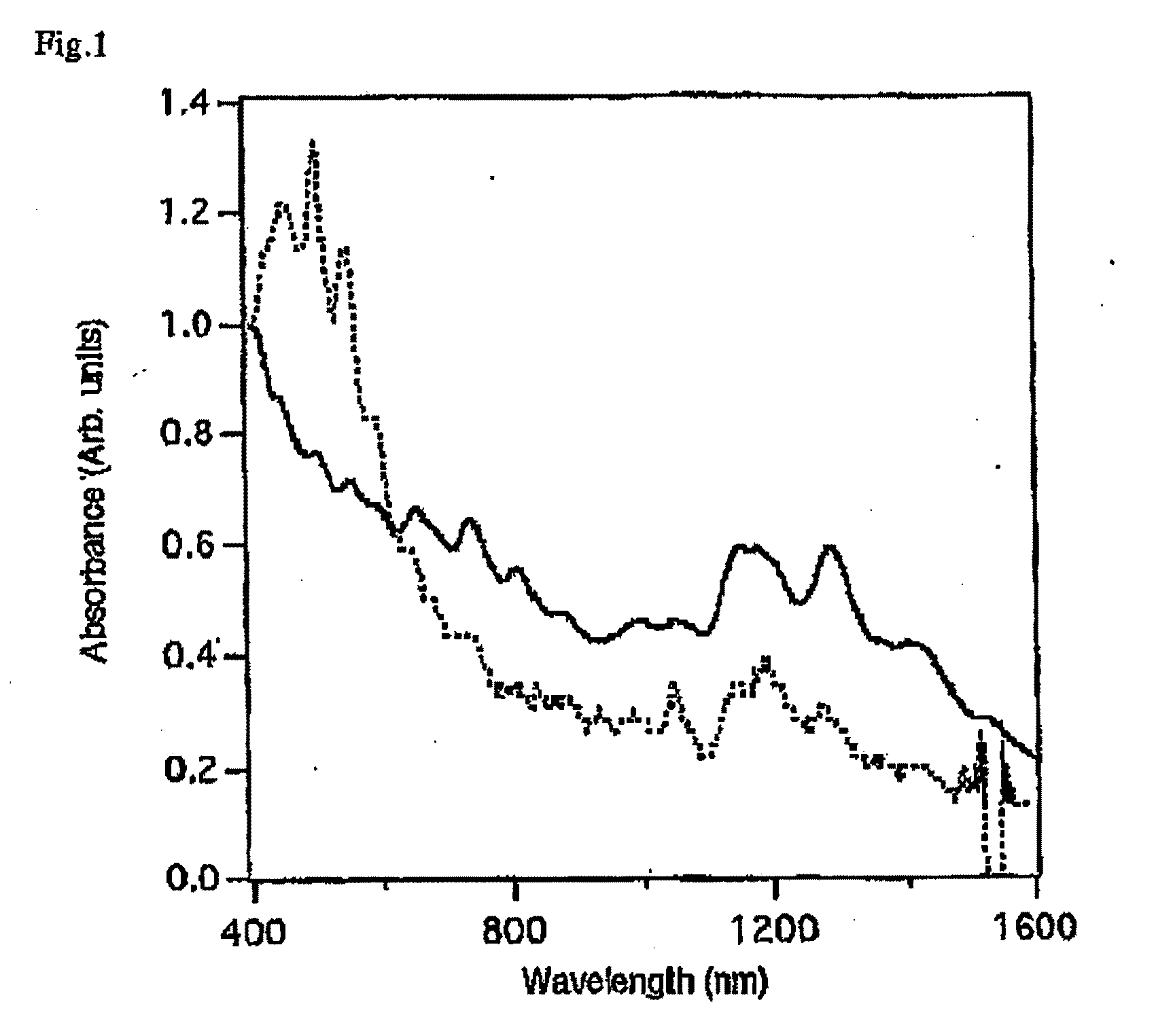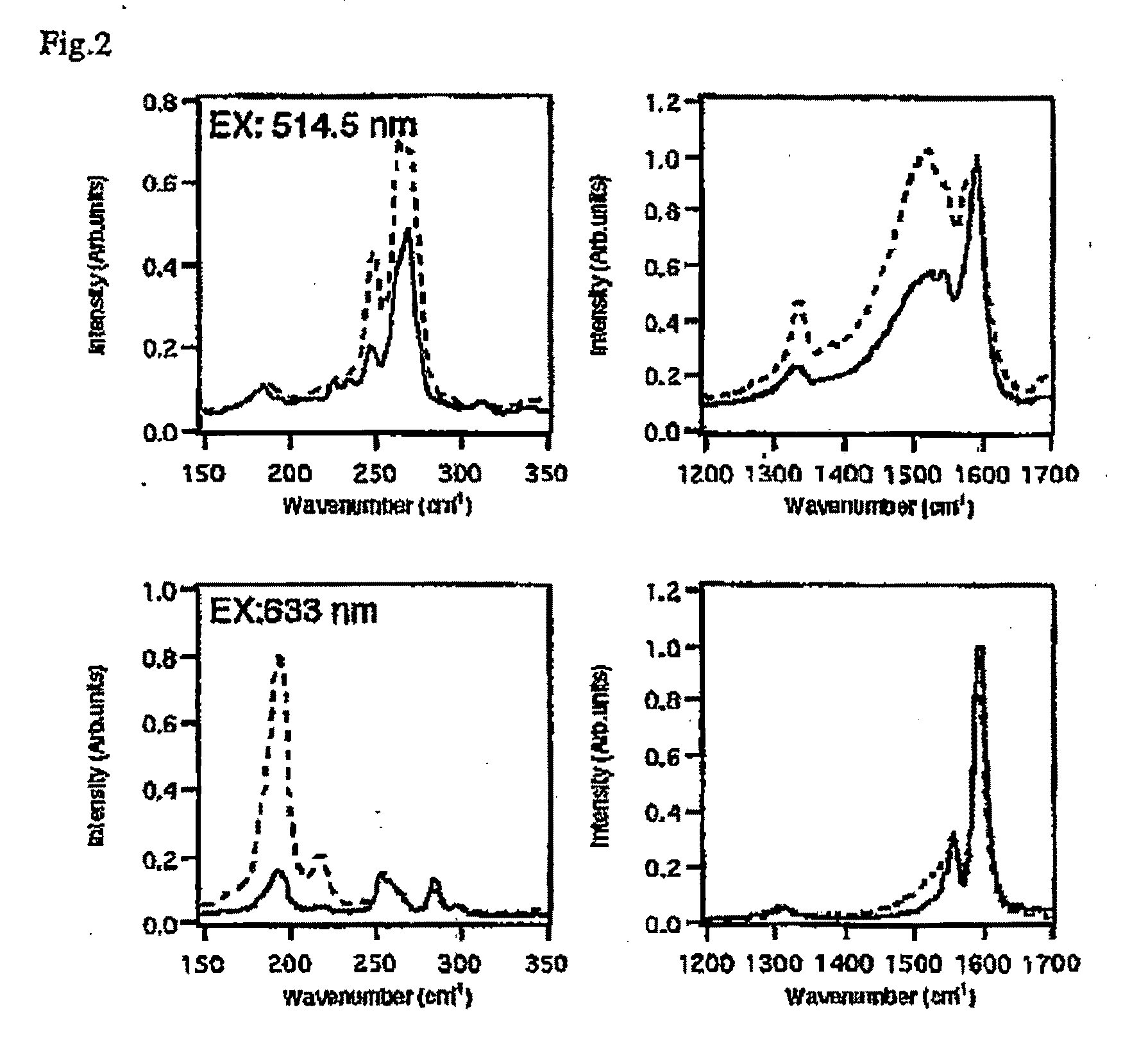Transparent Electroconductive Thin Film and Its Production Method
a technology of transparent electroconductive and thin film, which is applied in the direction of conductive layers on insulating supports, coatings, and paper, etc., can solve the problems of limited compatibility between the electroconductivity and light transmittance of thin films, the sense of crisis is increasing, and the indium cost is increasing, so as to achieve high electroconductivity and light transmittance good, high electroconductivity, and high electroconductivity
- Summary
- Abstract
- Description
- Claims
- Application Information
AI Technical Summary
Benefits of technology
Problems solved by technology
Method used
Image
Examples
example 1
[0067]4 mg of single-walled carbon nanotubes of m-SWNTs and s-SWNTs mixed as bundles (HiPco Tube, by Carbon Nanotechnologies, Inc.) were added to a 5 M propylamine solution (solvent: tetrahydrofuran) and then ultrasonically processed at 5 to 10° C. for 2 hours to thereby uniformly disperse the single-walled carbon nanotubes. Next, this was centrifuged at 45,620 G for 12 hours to prepare a dispersion (hereinafter referred to as “dispersion 1”).
[0068]On the other hand, 4 mg of the single-walled carbon nanotubes as above were added to a 1 M propylamine solution (solvent: tetrahydrofuran) and then ultrasonically processed at 5 to 10° C. for 2 hours to thereby uniformly disperse the single-walled carbon nanotubes. Next, this was centrifuged at 14,000 G for 1 hour to prepare a dispersion (hereinafter referred to as “dispersion 2”).
[0069]The single-walled carbon nanotubes in these dispersions 1 and 2 were analyzed through spectrometry. FIG. 1 shows absorption spectra in a wavelength range ...
example 2
[0081]Using an air brush, the dispersion 1 produced in Example 1 was uniformly applied onto the surface of a commercially-available quartz glass sheet having a thickness of 2 mm (transmittance: 93.3%) put on a hot plate at about 85° C., and the solvent tetrahydrofuran and the dispersant propylamine were removed through evaporation by the heat of the hot plate. Next, the thin film was washed with methanol to remove the amine residue, thereby giving a single-walled carbon nanotube thin film-coated quartz glass sheet.
[0082]The thickness of the single-walled carbon nanotube thin film was 28 nm, as measured with a surface profile analyzer. The single-walled carbon nanotube thin film was observed with a scanning electronic microscope and an atomic force microscope, which confirmed the absence of aggregates of single-walled carbon nanotubes but the presence of a large number of single-walled carbon nanotubes individually separated and uniformly dispersed in the film as kept in contact with...
example 3
[0088]Using the dispersions 1 and 2 in Example 1 and in the same manner as in Example 1, plural single-walled carbon nanotube thin films each having a different thickness were formed on the surface of a PET sheet, for which, however, the spraying amount through the air brush was controlled.
[0089]The relationship between the light transmittance and the surface resistivity of these single-walled carbon nanotube thin films are shown in FIG. 3, FIG. 4 and Table 1.
TABLE 1TransmittanceResistivity(after treatment(after treatmentNo. NTsCondition for SeparationSubstrateTransmittanceaResistivitybwith HCl)with HCl)1Dispersion 15 M PropylaminePET99.43600002Dispersion 15 M PropylaminePET98.7240003Dispersion 1b5 M PropylaminePET97.190004Dispersion 1b5 M PropylaminePET96.1480096.436005Dispersion 15 M PropylaminePET81.469082.13306Dispersion 15 M PropylamineQuartz80.78007Dispersion 21 M PropylaminePET98.811900008Dispersion 2c1 M PropylaminePET98.62150009Dispersion 2c1 M PropylaminePET90.23500090.610...
PUM
| Property | Measurement | Unit |
|---|---|---|
| boiling point | aaaaa | aaaaa |
| transmittance | aaaaa | aaaaa |
| transmittance | aaaaa | aaaaa |
Abstract
Description
Claims
Application Information
 Login to View More
Login to View More - R&D
- Intellectual Property
- Life Sciences
- Materials
- Tech Scout
- Unparalleled Data Quality
- Higher Quality Content
- 60% Fewer Hallucinations
Browse by: Latest US Patents, China's latest patents, Technical Efficacy Thesaurus, Application Domain, Technology Topic, Popular Technical Reports.
© 2025 PatSnap. All rights reserved.Legal|Privacy policy|Modern Slavery Act Transparency Statement|Sitemap|About US| Contact US: help@patsnap.com



